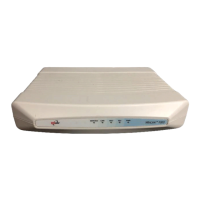Performing WinLink™ 1000 AIND Alignment Appendix G
WinLink™ 1000 User Manual Release 1.9 G-2
type installations, a long transmission line (RF cable) between the radio and
antenna will be used; oftentimes over 30 m (100 ft). In this case the atten-
uation (RF loss) of the cable must be determined (for both sides) and
entered as a dB loss in the Link Budget calculator. In many cases, a larger
antenna is necessary to compensate for this transmission line loss.
Andrew LDF and AVA cables are good for minimizing loss.
Performing WinLink™ 1000 AIND Alignment
The supervisor of the antenna alignment should be located at Site A with a
Spectrum Analyzer.
Equipment Setup
¾ To set up the antenna alignment equipment:
1. Coarsely align the two antennas. Use the compass readings taken during
the Site Survey to point the antennas in the correct direction.
2. Connect the equipment as shown in Figure G-1 but connect a spectrum
analyzer in place of the remote WinLink™ 1000-AIND.
3. Turn on the CW transmit signal from site A (from the WinLink™ 1000
NMS).
4. At site B, tune the SA to the frequency transmitted.
5. Increase the SA sensitivity according to the expected receive signal.
Aligning the antennas
¾ To align the antennas:
1. Slowly move the site B antenna azimuth axis (the elevation axis should
be locked) until you see the best signal on the SA Lock the azimuth axis.
2. Slowly move the site A antenna azimuth axis (the elevation axis should
be locked) until you see the best signal on the SA.
3. Lock the azimuth axis.
4. Slowly move the site B antenna elevation axis (the azimuth axis should
be locked) until you see the best signal on the SA.
Lock the elevation axis.
5. Slowly move the site A antenna elevation axis (the azimuth axis should
be locked) until you see the best signal on the SA.
Lock the elevation axis.
Note
When one antenna is moved, the opposite site is passive. Move the
antennas very slowly.

